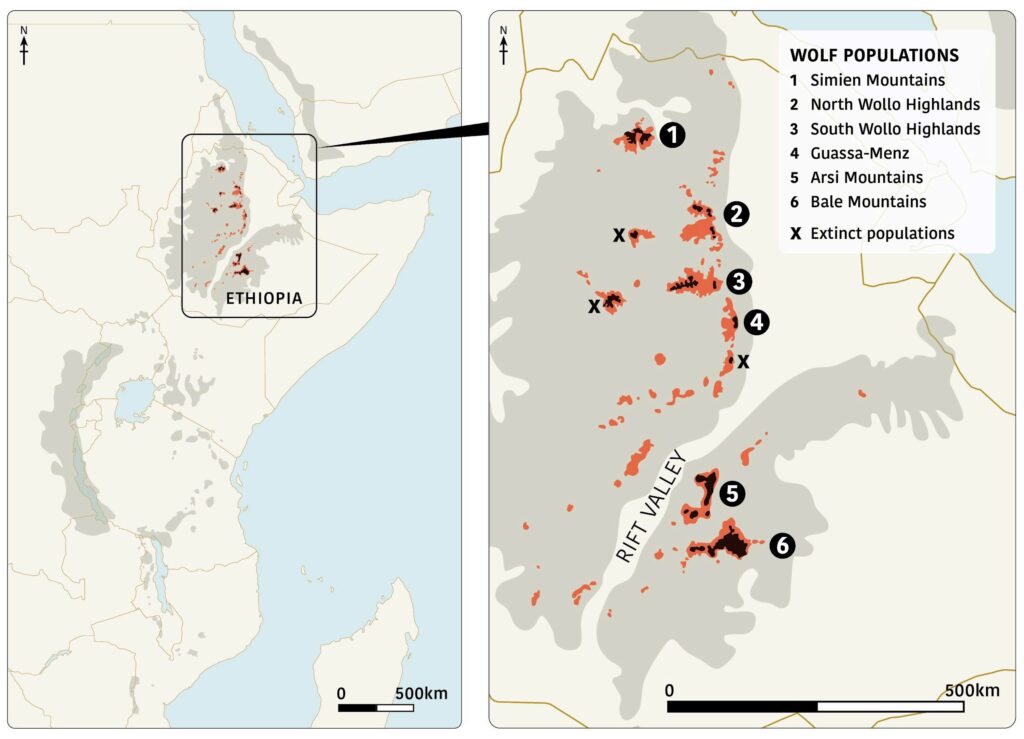CONSERVATION STATUS
The Ethiopian wolf (Canis simensis), also known as ky kebero or jedala farda, is Africa’s most endangered carnivore and the rarest canid on Earth, found only in the Afroalpine highlands of Ethiopia. With long limbs and elongated muzzles, they are highly specialized hunters of highland small mammals at elevations above 3,000 meters. Though these rare wolves are solitary hunters, they live in packs of 3–17 individuals at high densities (up to 2 wolves per km2) defending exclusive territories centred around a dominant breeding pair, assisted by cooperative breeding.
Fewer than 500 adults remain in just 6 isolated mountain ranges, with the largest population in the Bale Mountains (over half of the total). The other populations are critically small, some with fewer than 25 adult individuals. In recent decades, wolves have gone extinct in areas like Mt. Guna and Gosh Meda, underscoring the fragility and isolation of these high-altitude habitats.
The Ethiopian wolf is listed as Endangered on the IUCN Red List. Major threats include habitat loss and fragmentation due to agriculture and overgrazing, disease outbreaks (particularly rabies and canine distemper virus), road kills, and persecution – which is relatively rare. Inbreeding and genetic isolation pose a potential risk, though no significant loss of fitness has been observed yet in the smaller populations. These wolves are crucial predators and indicators of ecosystem health, sensitive to land use changes, disease, and climate impacts.

Current and extinct Ethiopian wolf populations. Grey areas show the Eastern Afromontane biodiversity hotspot; red denotes historical Afroalpine habitat; black denotes remaining Afroalpine habitat.
ETHIOPIAN WOLF RESEARCH AND CONSERVATION IMPACT HIGHLIGHTS
Over 30 years of pack observations by EWCP Wolf Monitors
New 2024 population estimate of ~450 wolves in 99 packs across 6 isolated populations
Radio-collars deployed in 10 packs across 2 populations
One WildCRU programme works on Ethiopian wolf research & conservation:
Key WildCRU publications relating to Ethiopian wolves:
Time allocation to balance group living trade-offs in Ethiopian wolves
Home range, habitat use, and activity patterns of African wolves (Canis lupaster) in the Ethiopian highlands
Time allocation to balance group living trade-offs in Ethiopian wolves
Living in groups requires individuals to make trade-offs to maintain group cohesion and enhance individual and inclusive fitness. One way animals can do this is by adjusting the way they allocate time to different behaviours. Ethiopian wolves (Canis simensis) are highly social, cooperative breeders (only the dominant pair breeds and all members help to raise the litter), but solitary foragers. To investigate how Ethiopian wolves allocate their time to balance the costs and benefits of group living, we analysed the time budgets of 47 wolves across six behaviours. We hypothesized that group size and territory density would affect wolves’ time allocation between solitary (foraging) and communal activities (patrolling and socialising) differently in relation to their age, dominance status or sex, and whether the pack was breeding or not. Our results showed that the time spent foraging alone increased at higher territorial densities, as expected from interference competition, particularly among subadults, subordinates and individuals in breeding packs. On the other hand, as pack size increased, adult wolves spent a lower proportion of time patrolling, while the time spent socialising did not change. Living in groups reduces the costs of communal activities, but crowded territories come at the cost of interference competition for solitary foragers, particularly the animals further down the hierarchy ranks, subadults, and individuals investing in breeding. Such trade-offs could impose an upper limit to group size and population growth within a limited space. Furthermore, anthropogenic disturbance could alter the balance of social and solitary activities of Ethiopian wolves.
Home range, habitat use, and activity patterns of African wolves (Canis lupaster) in the Ethiopian highlands
African wolves (Canis lupaster) and Ethiopian wolves (C. simensis) occur often sympatrically across habitats in the Ethiopian Highlands, with recent studies finding evidence for interspecific competition. However, unlike the well-studied Ethiopian wolf, comparatively little is known about the ecology of the African wolf in the Ethiopian Highlands. To address this empirical gap, we collected data on home range size, habitat use, and activity patterns of radio-collared African wolves at the Guassa Menz Community Conservation Area (GCCA) and Borena Saynt Worehimenu National Park (BSNP). We followed the African wolves (5 in GCCA, 6 in BSNP) for 16 months and had 659 ± 83 encounters with each individual. The mean 95% kernel density estimate home range size of African wolves was higher in BSNP (4.5 ± 1.5 km2) than at GCCA (2.2 ± 0.7 km2). In 55% (n = 3934) of the encounters the wolves were found to be solitary, whereas in other encounters we found them in groups of two to seven. At both sites, the African wolves were more often found in areas close to human settlements than in more intact habitat, and they were mainly active at dawn and dusk. These results show flexibility in African wolf socioecology in response to habitat fragmentation and anthropogenic disturbance. We recommend further studies on major causes of spatial and temporal niche partitioning of Ethiopian wolves and African wolves in the Ethiopian Highlands.